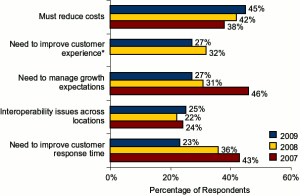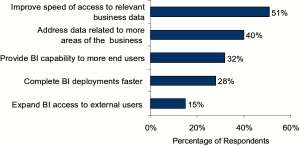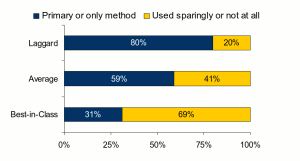
Globalization, supply chain complexity, and commodity and currency volatility combine to produce mountains of business data. In the past, just being able to collect and manage the data was task enough, but now companies are looking to mine the data mountain to drive actionable value.
Enterprise resource planning (ERP) systems provide much-needed capabilities, such as management of financial, product/inventory, human capital, purchasing, and other transactional data within one environment. The value proposition for investing in ERP has traditionally been tied to the standardization of business processes and centralization of information that makes it easier and faster to collect and manage data across many areas of the business. Increasingly, ERP customers have come to realize that the value from ERP investments can be increased dramatically through analysis of the consolidated data captured within and around the ERP system.
Enterprises of all shapes and sizes today are sitting on mountains of data resident in their transaction processing systems of record. While ERP solutions are at the very core of this transactional data, the volume and complexity of that data grows as ERP is surrounded by applications which extend its reach into areas such as customer relationship management, supplier and supply chain management, product lifecycle management and others. Given huge volumes of data from ERP and potentially other disparate sources, analyzing this information can be a challenge. Yet achieving transparency and visibility is no longer simply a lofty goal, but a core necessity of the business.
Business Drivers Behind ERP and BI
Over the past three years, Aberdeen has watched as the need to reduce costs bubbled to the top as the primary business driver behind ERP strategies (Figure 1). Together with growth and customer service, these three have dominated the pressures driving ERP implementation strategies. That is not to say that other factors do not come into play. Obviously, ERP provides the transactional audit trail that forms the auditable system of record for many companies, and as such helps them comply with regulatory and reporting requirements. However, those requirements are a “given,” and ERP is often viewed as a necessary infrastructure.
In the context of bringing transparency to the business and order to the potential chaos, perhaps the most significant of the extensions to ERP is business intelligence (BI). Think of it as a layer on top of or embedded within ERP and other applications which wind up being giant repositories of data.
While ERP and BI may indeed be implemented together, just as often they are viewed as separate initiatives. In the context of the business drivers behind BI projects, we must consider what needs are attempted to be satisfied. The top requirement of a BI deployment indeed coincides with the need to extract additional value from the relevant business data which is inherent to an ERP implementation (Figure 2). Improving the speed of access to this data is the key to transparency, visibility and informed decision-making.
The next two requirements relate to connecting the decision makers directly to the data that is needed to support those decisions. This may require broadening the scope and reach to new areas of the business, or it may mean providing access to data and tools to more knowledge workers within the organization. Both avenues lead to a clearer view of the data, which leads to a clearer view of the business. However, a clearer view is something that not all end-users agree comes from a BI solution. Many end-users still cling to spreadsheets as the medium of choice for integrating data and manipulating it via formulas and calculations. Therefore, it is important to understand why this is not a choice of Best-in-Class companies.
The Role of BI vs. Spreadsheets
Today, we hear a lot about doing “more with less” — less money, fewer resources, fewer people. That sentiment, however, rarely applies to data. Never have we been inundated with more data sources, both unstructured (via the news, the Web, and other sources) and structured data in enterprise applications, with data from ERP squarely at the hub. However, when is “more” actually “less?” When you don’t know it is there, when you can’t access it or when you have access but no context.
All of these reasons contribute to the fact that in spite of all the data that resides in ERP and other enterprise applications, executives, line managers and business analysts still rely heavily on spreadsheets for business intelligence. Few individuals coming out of business schools today are likely to willingly give up spreadsheets any time soon, but those that have met the criteria for Best-in-Class BI deployments have indeed relegated spreadsheets to more of a supporting role. (Figure 3).
Today, almost every ERP solution, and many other enterprise applications as well, have the ability to export data to spreadsheets. There is an inherent risk in providing this capability, populating a familiar tool with enterprise-level data. Best-in-Class companies make sure that in extracting data, the spreadsheet doesn’t take on a life of its own apart from the enterprise application. There is a trade-off between being able to access and work with the data offline, and making sure that it always reflects the most recent version (which requires that the user remain connected). In addition to being an effective reporting mechanism, spreadsheets can be a collaboration tool used to share data across applications, companies or partners, and therefore, a source of data and input. The trick is to import the data from the spreadsheet through the same controls and input mechanisms of the enterprise application, making sure to provide all the same data checks that ensure security and data integrity.
Combining ERP with powerful business intelligence software, the resulting synergies drive bottom-line savings and, in some cases, top-line growth. Amidst slumping world economic growth, the visibility and flexibility provided by a proper ERP and BI combination is no longer a luxury — it is a necessity.
David Hatch is vice president and group director of technology at Aberdeen Group.





















































